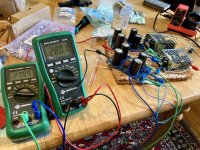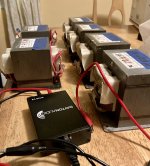Mine measure 0.5R to 0.6R with DATS v1. Have you calibrated your DATS? A DMM can’t measure that low accurately. At least my Flukes don’t do well below an ohm.
I tried the standard calibration and it failed no matter what. Kept giving a reading of around 33k instead of the expected 1k for the ‘ internal resistor.’ So I clipped a 1% 1k resistor (that measured 1k on my DMM) to the DATS leads and that worked for calibration. Honestly, it was angering that the product wasn’t working out of the box and support is all but absent. Hoping I didn’t waste my money. I will call PE tomorrow.
They are supposed to give you a 0.1% 1k calibration resistor in the kit. A 1% tolerance is up to 10ohms off at 1ohm.
That was with previous DATS versions. Apparently, the V3 module has the precision resistor installed internally. So calibration is supposed to work out of the box. I read that I probably need to plug the unit in directly to the PC (not a USB hub), so I’ll try that tomorrow morning.
I got the standard calibration to work. But I still got similar results for my two MOTs. So I imagine my DATS is working fine.
Is there such a thing as an inexpensive LCR meter worth getting? I’ll also study up on the more involved inductor testing, with load, etc…
Is there such a thing as an inexpensive LCR meter worth getting? I’ll also study up on the more involved inductor testing, with load, etc…
They are MD-803AMS-1, 120v/60Hz 
They should be ok… Worked for MoFo, with good specs. https://www.diyaudio.com/community/threads/build-this-mofo.313649/post-5641280
I think I need a more trustworthy measurement. I’ll see how the four additional ones test and decide if I need a different measurement setup.

They should be ok… Worked for MoFo, with good specs. https://www.diyaudio.com/community/threads/build-this-mofo.313649/post-5641280
I think I need a more trustworthy measurement. I’ll see how the four additional ones test and decide if I need a different measurement setup.
Last edited:
Another hurdle cleared: RPS-200-27 powers up fine with diyAudio Store power supply V3 filter board populated with 4x10mF caps. No CL60 needed. 🤘😎🤘
https://www.diyaudio.com/community/...3-illustrated-build-guide.244788/post-7082246
https://www.diyaudio.com/community/...3-illustrated-build-guide.244788/post-7082246
Attachments
That's cool 👍Another hurdle cleared: RPS-200-27 powers up fine with diyAudio Store power supply V3 filter board populated with 4x10mF caps. No CL60 needed. 🤘😎🤘
https://www.diyaudio.com/community/...3-illustrated-build-guide.244788/post-7082246
Just for my understanding - it's 5:45 in the morning and I'm already sitting in a train so my brain is sleeping -, you will use this power supply with the filter board instead of any other, one per channel? I'm asking so dumb because I have problems to get some important parts for the recommended power supply, so this could be THE solution for me too. And no transformers, just this switching thingie.
I have time 🙂 Altough I already have all the parts for the boards and for the FE-stage (in my case the Dreadnought), I stopped the project because of the power supply - but now I will restart it.
Hi X,
what is your opinion re the use of the switching power supplies for the amp? (Just because I have two in the basket.)
what is your opinion re the use of the switching power supplies for the amp? (Just because I have two in the basket.)
Switching supplies are fine for Class A amps. The trick is to get it to work without going into self protection / hiccup mode due to the high current draw. One can use SSR with an NTC as a soft start circuit if that’s the case. Some SMPS use a topology that does not have issues with high startup current draw. A good SMPS can be a very quiet PSU for Class A. Which one do you have?
Reading the whole thread (again) I noticed that the BA2018 line stage might be able to drive the amp. Has anyone tried this setup and can confirm? I "accidentally" have the line stage.
I think BA18 should work - but you might check back in the BA18 thread for that. You need 55Vpp of output. The transistors on the circuit should be able to handle that. It’s a matter of maybe adjusting some DC setpoints. Mine ran really hot at +/-29v rails.
- Home
- Amplifiers
- Pass Labs
- LuFo Amp - 39w SE Class A from 28v Rail


